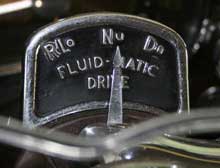Fluid-Matic
Many months ago, the CarPort explored the marvels and mysteries of Fluid Drive. That installment covered only through 1948, a turning point of sorts. In this episode we tell, as Paul Harvey would say, the rest of the story.
Actually, changes for 1949 were fairly minor. A new M-6 transmission replaced the M-5 unit, but the differences were subtle: simplified valving and wiring. More significant was the extension of the semi-automatic box to Dodge, which called it Gyro-Matic. Chrysler and DeSoto continued into 1950 with Prestomatic and Tip-Toe Shift, respectively.
The next change was rather illusory, perhaps a marketing gimmick. For 1951, Chrysler renamed the system "Fluid-Matic," and added a shift quadrant to the steering column. The shifter operated the same way as it had before, and could still be easily handled by "feel" since it retained a modified "H" pattern, but probably the competition's onrush of fully-automatic transmissions, like Hydra-Matic and Fordomatic, on which an indicator quadrant was essential, convinced Chrysler that a quadrant, however unnecessary, was important.
The more significant change for 1951 was Fluid-Torque, basically replacement of the fluid coupling with a torque converter. Standard equipment on Imperials and optional on New Yorkers, Fluid-Torque was extended to DeSoto with the new Firedome hemi in 1952 and to six-cylinder Chryslers. In mid-1952, a new configuration was ushered in, one that used engine oil in the torque converter. Air cooling blades were also added to the outside of the converter.
For 1953, all Chryslers, DeSotos and Dodges offered the new Fluid-Torque, although in the case of Dodge it was dubbed "Gyro-Torque." Interestingly, Chrysler kept the shift quadrant, but deleted the name, perhaps because all models were now "torquey." Interestingly, while Chrysler used the "short form" of "Fluid-Torque," DeSoto clung to its Tip-Toe Shift designation, adding "Fluid Drive" or "Fluid-Torque" as appropriate.
For 1954, this all became moot, as the fully-automatic PowerFlite, stealthily fielded in late-1953 Imperials, reached the "upper three" Chrysler marques. The PowerFlite quadrant was simple and devoid of boasts, the bragging rights being relegated to the rear of the cars.
And what of Plymouth? Ah, the frequently misunderstood Hy-Drive, a combination so intriguing it deserves its own CarPort, sometime soon.

